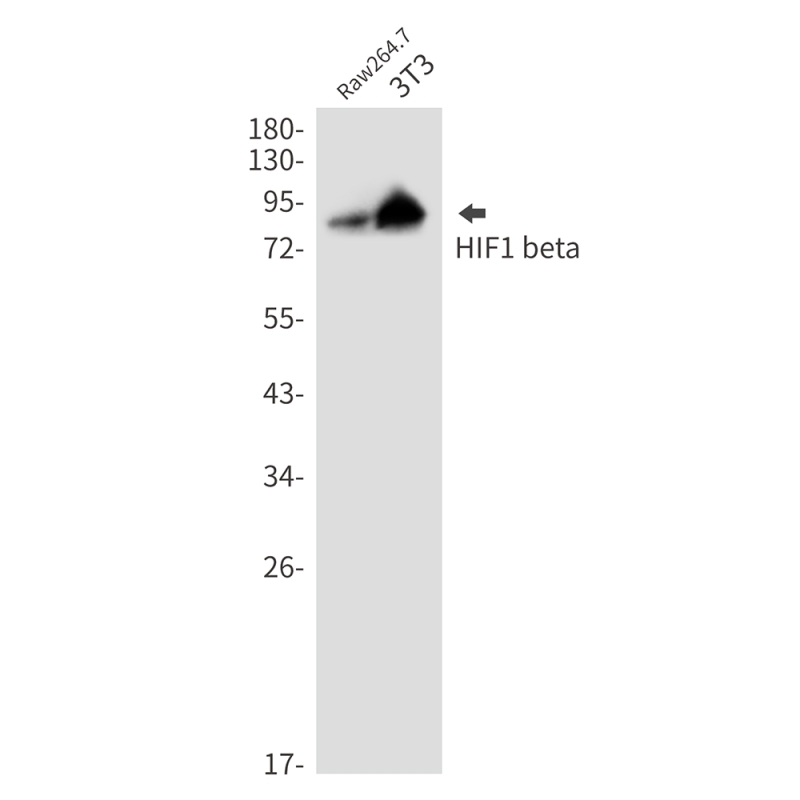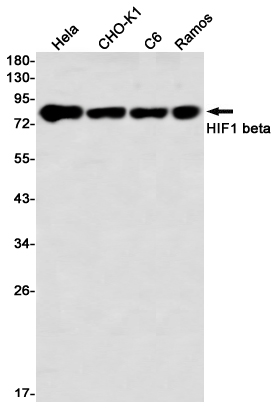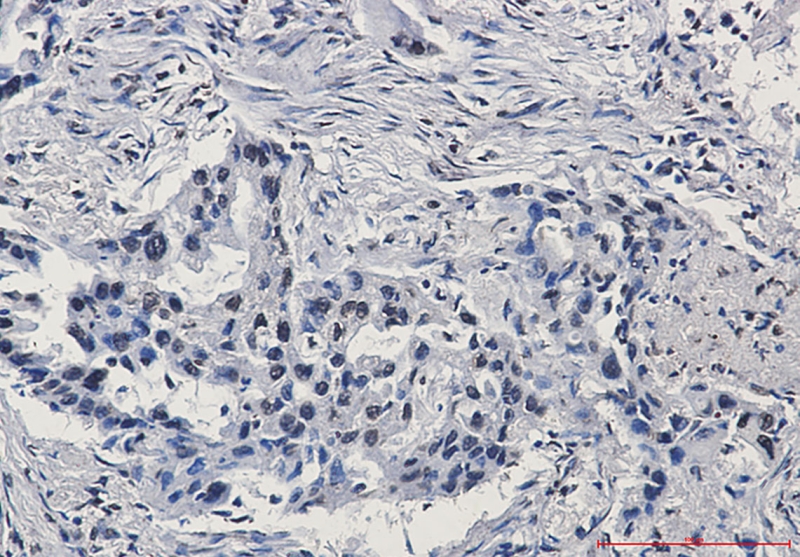


| WB | 1/500-1/1000 | Human,Mouse,Rat,Hamster |
| IF | 咨询技术 | Human,Mouse,Rat,Hamster |
| IHC | 1/50-1/100 | Human,Mouse,Rat,Hamster |
| ICC | 技术咨询 | Human,Mouse,Rat,Hamster |
| FCM | 咨询技术 | Human,Mouse,Rat,Hamster |
| Elisa | 咨询技术 | Human,Mouse,Rat,Hamster |
| Aliases | ARNT; BHLHE2; Aryl hydrocarbon receptor nuclear translocator; ARNT protein; Class E basic helix-loop-helix protein 2; bHLHe2; Dioxin receptor; nuclear translocator; Hypoxia-inducible factor 1-beta; HIF-1-beta; HIF1-beta |
| Entrez GeneID | 405 |
| WB Predicted band size | Calculated MW: 87 kDa; Observed MW: 87 kDa |
| Host/Isotype | Rabbit IgG |
| Antibody Type | Primary antibody |
| Storage | Store at 4°C short term. Aliquot and store at -20°C long term. Avoid freeze/thaw cycles. |
| Species Reactivity | Human,Mouse,Rat,Hamster |
| Immunogen | Recombinant protein of human HIF1 beta |
| Formulation | Purified antibody in TBS with 0.05% sodium azide,0.05%BSA and 50% glycerol. |
+ +
以下是3篇与HIF1β(ARNT)抗体相关的文献摘要,按研究主题分类整理:
---
1. **文献名称**:*Hypoxia-inducible factor 1α/ARNT complex regulates the human IGFBP3 promoter in vitro*
**作者**:Zelzer E, Levy Y, Kahana C, et al.
**摘要**:本研究利用HIF1β(ARNT)抗体通过染色质免疫共沉淀(ChIP)验证HIF1α/ARNT复合物在低氧条件下直接结合人类IGFBP3基因启动子,揭示了该复合物对细胞生长因子调控的分子机制。
---
2. **文献名称**:*ARNT-dependent HIF1β stability regulates breast cancer cell migration under hypoxia*
**作者**:Jiang BH, Agani F, Passaniti A.
**摘要**:通过Western blot和免疫荧光技术,作者发现HIF1β蛋白在乳腺癌细胞中的稳定性依赖ARNT表达,并证明其通过调控VEGF通路促进肿瘤细胞在低氧环境中的迁移能力。
---
3. **文献名称**:*Tissue-specific expression of HIF1β/ARNT in murine embryonic development*
**作者**:Kozak KR, Abbott B, Hankinson O.
**摘要**:利用HIF1β抗体进行免疫组化分析,发现ARNT在小鼠胚胎心脏和神经管发育中高表达,提示其在器官形成中可能通过调控低氧响应通路发挥作用。
---
**备注**:如需具体DOI或发表年份,可进一步补充数据库检索条件(如限定研究领域或物种)。部分早期经典文献可能需手动核实引用格式。
HIF1 beta antibody is a key tool for studying the hypoxia-inducible factor 1 (HIF-1) pathway, a central regulator of cellular responses to low oxygen conditions. HIF-1 is a heterodimeric transcription factor composed of HIF-1 alpha (oxygen-sensitive subunit) and HIF-1 beta (constitutively expressed subunit, also known as ARNT). While HIF-1 alpha is degraded under normoxia, HIF1 beta remains stable and partners with other alpha subunits (e.g., HIF-2α, HIF-3α) or aryl hydrocarbon receptor (AhR) to regulate diverse genes involved in angiogenesis, metabolism, and tumor progression.
HIF1 beta antibodies are widely used in techniques like Western blotting, immunofluorescence, and chromatin immunoprecipitation (ChIP) to investigate its expression, localization, and interactions. These antibodies typically target conserved regions, such as the N-terminal basic helix-loop-helix (bHLH) or PAS domains, ensuring specificity across human, mouse, and rat samples. Validated applications include studying hypoxia-related diseases (cancer, ischemia), toxicology (AhR-mediated detoxification), and developmental biology.
Commercial HIF1 beta antibodies are available from major suppliers (e.g., CST, Abcam), often verified via knockout controls. Researchers prioritize clones with minimal cross-reactivity to related proteins (e.g., ARNT2). Proper validation is critical, as HIF1 beta's stability and ubiquitous expression make it a common loading control in hypoxia studies, despite its dynamic role in signaling crosstalk.
×